
Requests
The Oregon Workers’ Compensation Board received 11,266 requests for hearing in 1997, including 883 stipulations received without a prior hearing request. That’s a decrease of 8.8 percent from 1996 and the fewest requests since 1980.
The worker requested the hearing in 89.7 percent of the cases (excludes “joint” requests). This was the first time that this percentage has been below 90 percent.
Closures
In 1997 there were 11,676 closing orders, about 12.5 percent fewer than the previous year.
Notes: This report excludes safety cases. The data below, except Figure 1, include only cases involving compensation to the worker, so cases dealing solely with noncomplying status or civil penalty are excluded. Discussions of issues and their dispositions apply to opinion and order (O&O) and stipulation cases. Stipulations include disputed claim settlements (DCSs).
There were 3,038 cases closed by O&O, 26.3 percent of
all cases (the highest percentage since 1992). Stipulations closed
5,360 cases (46.3 percent), dismissals and withdrawals closed
3,171 cases (27.4 percent), and arbitrator’s decision closed
2 cases (a single responsibility dispute).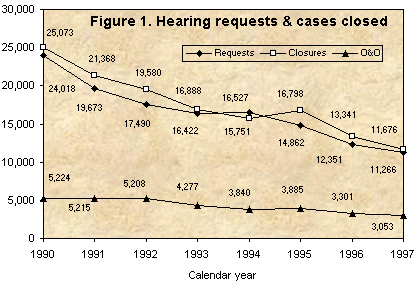
SAIF was the insurer in 33.5 percent of the cases, the sixth consecutive record-low percentage. Private insurers accounted for 49.9 percent, and self-insured employers 16.4 percent of the cases.
Issues
Figure 2 depicts the numbers of issues resolved at hearings. Claim denial was the most frequent issue (as it has been every year since 1988), with 46.6 percent of all cases. The percentage of cases with the issue of partial denial was 24.6 percent, down significantly from 1996’s record-high 34.4 percent. Extent of permanent and temporary disability were involved in 10.1 and 4.4 percent of cases, respectively. (Note: the attorney fee issue is excluded from the other-issue count because of temporary misapplication of coding criteria for this issue during 1997.)
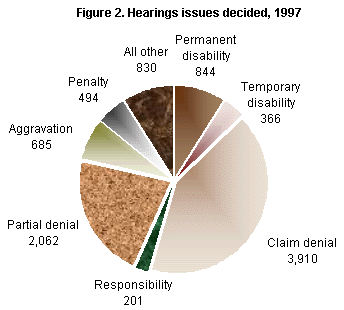
Permanent disability
Only 844 cases involved this issue, the fewest on record and
91.0 percent below 1987’s peak of 9,372 cases. The 10.1
percentage frequency, 49.4 percent granting an increased award,
and $1.3 million net PPD awarded (Figure 3)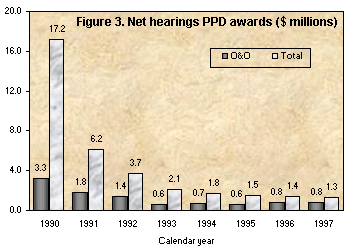 are also record-low values. On the other hand,
the average PPD increase of 19.5 degrees (combining scheduled
and unscheduled awards) was the highest since 1991. There were
seven PTD grants (Figure 4), of which three were by stipulation,
and no PTD rescissions.
are also record-low values. On the other hand,
the average PPD increase of 19.5 degrees (combining scheduled
and unscheduled awards) was the highest since 1991. There were
seven PTD grants (Figure 4), of which three were by stipulation,
and no PTD rescissions.
Issue dispositions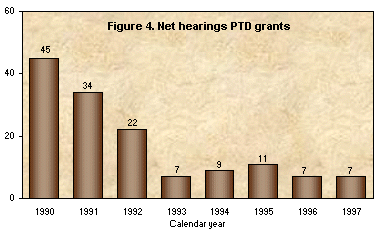
The percentages of O&O cases decided in favor of the worker
were as follows: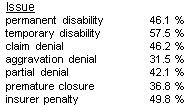
The favorable rate for partial denial was the lowest since 1986. For the disability issues, the rates reflect award increases (37.5 and 56.2 percent, respectively, for permanent and temporary disability), plus insurer or employer hearing requests when the disability award is affirmed.
Disputed claim settlements
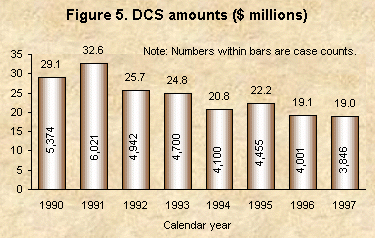 Figure 5 depicts
the total value of DCSs, amounts paid to workers as consideration
for not contesting a denial. The 3,846 DCS cases constituted
71.8 percent of all stipulations and 33.2 percent of all orders,
both record-high values. DCSs accounted for 74.5 percent of all
hearings denied claims (excludes aggravations), and 42.9 percent
of all claimant attorney fees at hearings. The average DCS amount
was $4,929.
Figure 5 depicts
the total value of DCSs, amounts paid to workers as consideration
for not contesting a denial. The 3,846 DCS cases constituted
71.8 percent of all stipulations and 33.2 percent of all orders,
both record-high values. DCSs accounted for 74.5 percent of all
hearings denied claims (excludes aggravations), and 42.9 percent
of all claimant attorney fees at hearings. The average DCS amount
was $4,929.
Time lags
For all O&O cases, the median time from hearing request to order was 155 days (5.1 months), one day shorter than for 1996. For O&O cases without a postponement, the median request-to-order time was only 117 days (3.8 months).
Attorney fees
Fees awarded to workers’ attorneys totaled about $8.5 million, 6.4 percent less than in 1996. The average fee was $1,447 (combined out-of-compensation and assessed), 5.2 percent greater than for 1996. About 48.5 percent of all fees were paid out of worker compensation.
Mediation activity
In 1997 administrative law judges completed 250 mediations in order to settle disputes without formal litigation. About 91.6 percent of these mediations resulted in settlement. Over 40 percent of mediations included issues in addition to workers’ compensation (employment rights, Americans with disability act, tort, etc.). The average mediation required about 12 work-hours on the part of the judge.
If you have questions about the information contained in this document please contact by e-mail or phone: Russell Reed, Research Analyst, Research & Analysis Section, Information Management Division (503) 947-7343.
This document was originally published in December 1998.
Document URL: http://www.cbs.state.or.us/external/imd/rasums/7_2106.html
[Printed form: 440-2106(12/98/IMD)]
In compliance with the Americans with Disabilities Act (ADA), this publication is available in alternative formats by calling (503) 378-4100 (V/TTY).